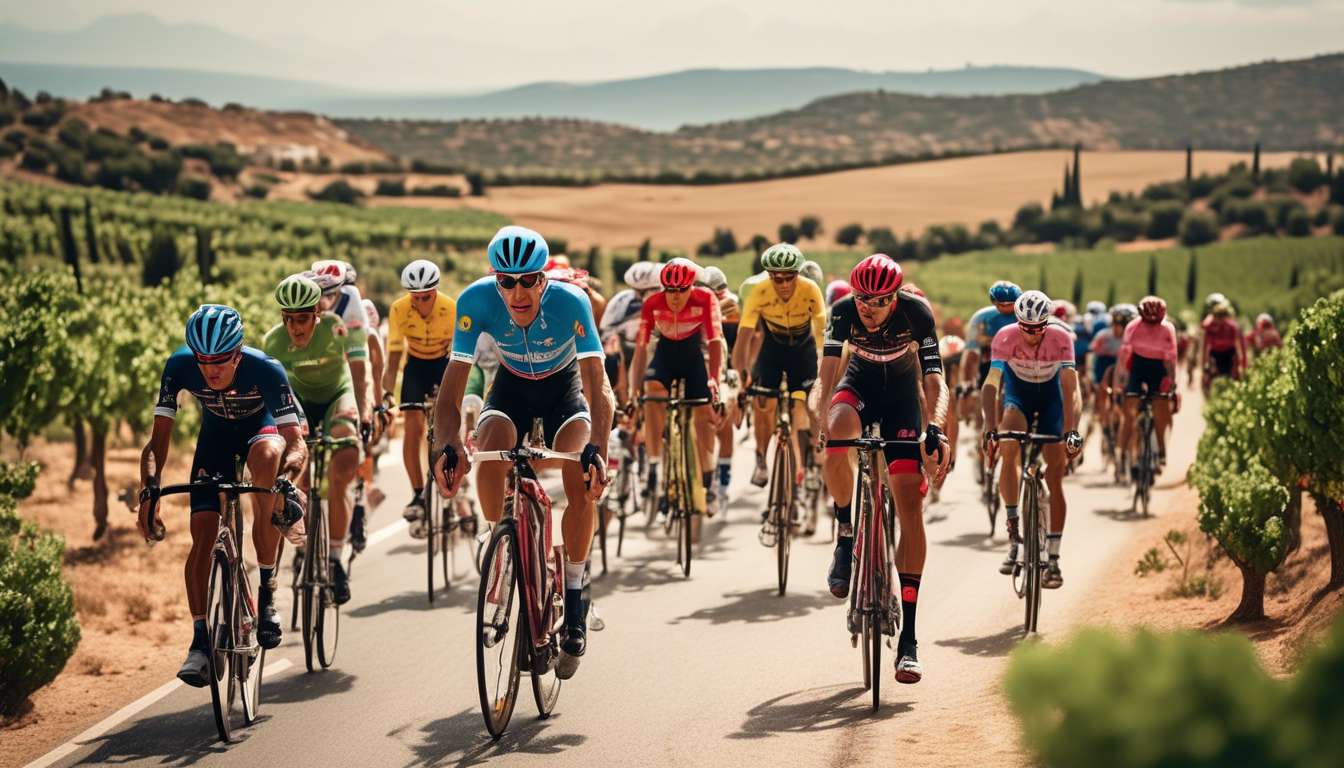The Grand Tours of Professional Cycling
When we think of the grand tours in the world of professional cycling, our minds immediately race to three iconic events:
- The Tour de France – Known for its thrill and prestige.
- The Giro d’Italia – Famous for its challenging terrain.
- The Vuelta a España – Celebrated for its vibrant allure.
Each of these races embodies a unique spirit, offering its own set of challenges and rewards.
Comparative Journey
As avid cycling enthusiasts, we often debate which of these illustrious races holds the crown for being:
- The most demanding.
- The most scenic.
- The most unpredictable.
Exploring the Vuelta’s Uniqueness
We embark on a comparative journey, delving into the nuances that set the Vuelta apart from its illustrious counterparts. This exploration covers:
- The physical demands these tours place on cyclists.
- The cultural tapestry they weave across their respective countries.
- The geographical landscapes that define them.
Join Us
Together, let’s pedal through the contrasts and similarities that define the world’s most celebrated cycling tours.
Historical Significance
The Vuelta a España, introduced in 1935, holds a unique place in cycling history as the youngest of the three Grand Tours, following the Tour de France and Giro d’Italia. This event symbolizes endurance and excellence, and participants often feel a sense of camaraderie and shared passion due to its status as a major cycling event.
Distinct Flavor of the Vuelta:
- The Vuelta offers a distinct flavor compared to its older siblings.
- It is shaped by Spain’s diverse landscapes and challenging terrain.
Climbing Intensity:
- The Vuelta a España is renowned for its climbing intensity.
- It pushes riders to their limits across steep mountains and unpredictable weather conditions.
The Vuelta’s demanding routes test even the most seasoned cyclists, creating an atmosphere where the entire cycling community rallies together, supporting each other through every grueling ascent.
Legacy of the Vuelta:
- Historical significance
- Rooted in resilience
- Embodies the spirit of competition
As we reflect on its historical significance, we realize the Vuelta has carved out its own legacy.
Route Challenges
Riders face some of the toughest route challenges, navigating Spain’s diverse and rugged terrain that often includes steep ascents and unpredictable weather. The Vuelta a España, one of the prestigious Grand Tours, offers a unique set of challenges that test both physical endurance and mental resilience. As we pedal through this iconic race, we’re united by the camaraderie and shared experience of tackling intense climbs and navigating narrow, winding roads.
While the Vuelta a España shares similarities with other Grand Tours, its routes are renowned for their climbing intensity. We find ourselves scaling mountains that push our limits and demand strategic planning. The dramatic landscapes of Spain, from the searing heat of the plains to the lush greenery of the northern regions, create a backdrop that’s both beautiful and unforgiving.
Together, we embrace these challenges, knowing that each stage is an opportunity to bond, grow, and celebrate our collective passion for cycling. As we conquer these routes, we become part of a larger narrative that defines the spirit of the Vuelta a España.
Climbing Intensity
Among the defining features of the Vuelta a España, the grueling and relentless climbs stand out, pushing us to our limits with each ascent. As cycling enthusiasts, we share a collective awe for this Grand Tour’s climbing intensity. Unlike the Tour de France or the Giro d’Italia, the Vuelta is renowned for its vertical challenges, often featuring steep, punishing gradients.
The Vuelta’s mountainous stages form a unique bond among us, as we appreciate the sheer determination required to conquer them.
These climbs aren’t just about physical endurance; they forge a sense of camaraderie and mutual respect among riders and fans alike. The Vuelta a España consistently introduces us to lesser-known peaks, offering fresh challenges that test our mettle.
This emphasis on climbing intensity distinguishes the Vuelta within the world of Grand Tours. Together, we revel in the thrill and struggle, knowing these ascents are not just obstacles, but milestones in our shared journey through the sport we love.
Time Trial Emphasis
Time trials in the Vuelta a España bring a unique strategic dimension to the race, requiring a balance between speed and stamina. These stages challenge riders to push their limits individually, contrasting with the collective effort seen during the climbing intensity of mountain stages.
Key Differences from Other Grand Tours:
- Unlike the Giro d’Italia or Tour de France, where time trials can heavily influence the overall standings, the Vuelta often treats these segments as tactical chess games.
- Outcomes are not solely dependent on raw power, making strategy crucial.
Impact on the Race:
- Time trials can make or break chances at victory, and the Vuelta a España is no exception.
- Riders must carefully gauge their energy, knowing that subsequent climbing stages demand just as much focus and endurance.
- This delicate balance distinguishes the Vuelta, binding riders, fans, and enthusiasts as a community.
In Conclusion:
Together, we embrace the unique challenges that time trials add to the tapestry of this storied race, appreciating their role in the overall dynamics of the Vuelta a España.
Spectator Experience
Spectators at the Vuelta a España enjoy an unparalleled experience, with the race’s vibrant atmosphere and scenic routes captivating fans from start to finish. We find ourselves drawn to the Vuelta not just for the cycling, but for the sense of community it fosters.
As part of the Grand Tours, the Vuelta a España stands out by offering a blend of cultural immersion and thrilling competition. The climbing intensity during the mountain stages brings us together, sharing the excitement of each ascent and cheering on our favorite riders.
The Vuelta’s unique landscapes, from sun-soaked coastlines to rugged peaks, create a backdrop that enhances our connection to the event. Together, we revel in the electric energy of the crowd, united in our passion for cycling.
Unlike other Grand Tours, the Vuelta’s intimate setting allows us to feel closer to the action. We gather along the roadsides, embracing the camaraderie that this spectacular event inspires.
Team Strategies
In the Vuelta a España, teams meticulously plan their strategies to adapt to the race’s challenging terrain and unpredictable conditions. The Vuelta’s climbing intensity is legendary among the Grand Tours, making it essential for teams to focus on their climbers.
Our team strategies revolve around supporting our lead climbers during the grueling ascents, knowing these are where time can be gained or lost. Together, we work to ensure our riders are not just strong, but also tactically astute.
Unlike other Grand Tours, the Vuelta often throws unexpected challenges our way, demanding flexibility and quick thinking. We prioritize unity and communication to navigate these hurdles, fostering a sense of belonging among all team members.
As we tackle the high mountains and steep gradients, our collective effort and camaraderie become our greatest assets. By fostering a strong team spirit, we aim to conquer the unique demands of the Vuelta a España, standing united in pursuit of victory.
Weather Conditions
Weather Conditions and Strategy Adaptation
Weather conditions during the Vuelta can be unpredictable, requiring us to constantly adapt our strategies to cope with sudden changes. Unlike other Grand Tours, the Vuelta a España often challenges us with:
- Sweltering heat
- Sudden rain
- Gusty winds
These elements can occur all in a single stage. We find ourselves battling not just the terrain but also the elements, which adds to the climbing intensity and demands our unity and resilience.
Unique Weather Patterns
In the Vuelta, the diverse Spanish landscapes offer unique weather patterns that differ from those in the Giro d’Italia or the Tour de France. As a team, we:
- Share our experiences and insights to anticipate these conditions.
- Foster a sense of belonging and camaraderie.
Collective Strength and Adaptability
Whether it’s the relentless heat of the Andalusian plains or the chilling winds of the Cantabrian mountains, we rely on our collective strength and adaptability. Together, we embrace these challenges, knowing they shape our journey through one of cycling’s most formidable Grand Tours.
Winner’s Profile
Every champion of the Vuelta a España embodies a unique blend of endurance, tactical acumen, and adaptability to thrive in its demanding stages. The Vuelta is distinct among the Grand Tours, with its notorious climbing intensity challenging even the most seasoned riders. Winners aren’t just physically prepared; they’re mentally resilient, capable of navigating the grueling ascents and adapting to rapidly changing race dynamics.
In comparison to the Tour de France and the Giro d’Italia:
- The Vuelta’s stages often feature steeper, shorter climbs.
- These climbs require explosive power and strategic positioning.
This means that successful riders must excel not only in long, sustained efforts but also in quick, decisive uphill sprints.
Our community of cycling enthusiasts appreciates riders who:
- Rise to these challenges with determination and skill.
- Remind us of the camaraderie and shared passion that binds us together.
As we cheer for our favorites, we celebrate the unique attributes that define Vuelta champions.
How does the Vuelta a España’s prize money compare to the other Grand Tours?
When comparing the prize money of the Vuelta a España to other Grand Tours, several factors should be considered to provide an accurate comparison:
1. Factors Influencing Prize Money:
- Sponsorship deals
- Overall budget of the event
2. Essential Steps for Accurate Comparison:
- Gather Recent Data:
- Look into the most recent editions of the Vuelta a España, Tour de France, and Giro d’Italia.
- Consult Official Sources:
- Review official race websites and press releases for the latest prize money details.
3. Comparison Analysis:
- Analyze the differences in prize distribution among the three Grand Tours.
- Note any significant changes or trends over recent years.
By following these steps, a clear and updated understanding of how the Vuelta a España’s prize money compares to other Grand Tours can be achieved.
What unique cultural aspects are highlighted during the Vuelta a España that set it apart from the Tour de France and Giro d’Italia?
During the Vuelta a España, we immerse ourselves in Spain’s vibrant culture. The race showcases the country’s diverse landscapes, ranging from stunning coastlines to historic cities.
Cultural Highlights:
- Flamenco music
- Delicious paella
- Passionate fans
These elements add to the unique atmosphere of the event.
The Vuelta’s red jersey symbolizes Spain’s fiery spirit, setting it apart from the Tour de France and Giro d’Italia.
This cultural richness makes the Vuelta a España a truly special event for everyone to enjoy.
How do the dietary and nutritional strategies of cyclists differ when preparing for the Vuelta a España compared to other Grand Tours?
Gearing Up for the Vuelta a España: Dietary and Nutritional Game Plan
When preparing for the Vuelta a España, our dietary strategy shifts to meet the race’s demands.
Key Nutritional Focus:
-
Carbohydrates: Essential for energy, we increase our intake to sustain long rides over challenging terrain.
-
Proteins: Important for muscle repair and recovery, we incorporate adequate amounts into our diet.
-
Fats: Healthy fats provide a concentrated energy source and help maintain stamina.
Hydration:
Hydration becomes crucial as we contend with the intense Spanish heat.
- We ensure consistent fluid intake to prevent dehydration and maintain performance levels.
Fine-tuning Nutrition:
The goal is to optimize our nutrition for peak performance throughout the race, adjusting our intake as needed to match daily demands.
Conclusion
In conclusion, when comparing the Vuelta a España to other Grand Tours, it’s evident that each race offers its own unique challenges and attractions.
From historical significance to climbing intensity and team strategies, all aspects play a crucial role in determining the ultimate winner.
Whether you’re a fan of:
- the grueling climbs
- the thrilling time trials
there’s something for everyone in these prestigious cycling events.
So, grab your gear and get ready to experience the excitement of these iconic races firsthand.




